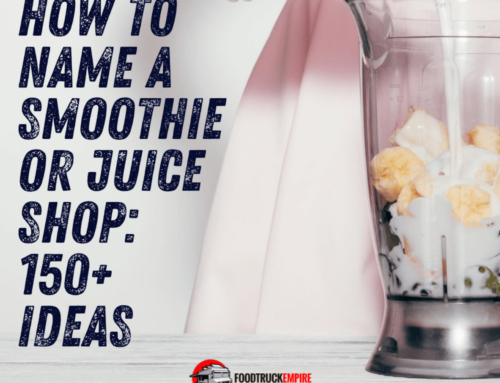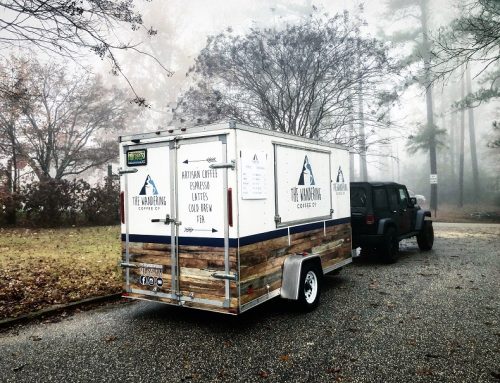When I started my food truck business, I dedicated a full year to planning and researching every detail. From obtaining health permits to finding the perfect food truck builder, every step in the process felt like a major hurdle. And let’s not even talk about learning to parallel park a food truck!
Back in 2012, when I began researching this business, there was almost no information online about food trucks. Much of my research involved trial and error, seeking help from fellow food truck owners, and making countless calls to the local health department to understand the necessary codes. In short, it was a time consuming process.
That’s why I’m sharing these eight steps to help you start your own food truck. I want to set you on the path to sharing your love of food with the world without all the headaches. Let’s get started!
Food Truck Startup Outline:
- Make your menu
- Write a food truck business plan
- Estimate total startup costs
- Food truck funding options
- Licenses, permits and insurance
- Find a Point-of-Sale System
- Register Social Media Accounts
- Open for business
- Frequently asked questions
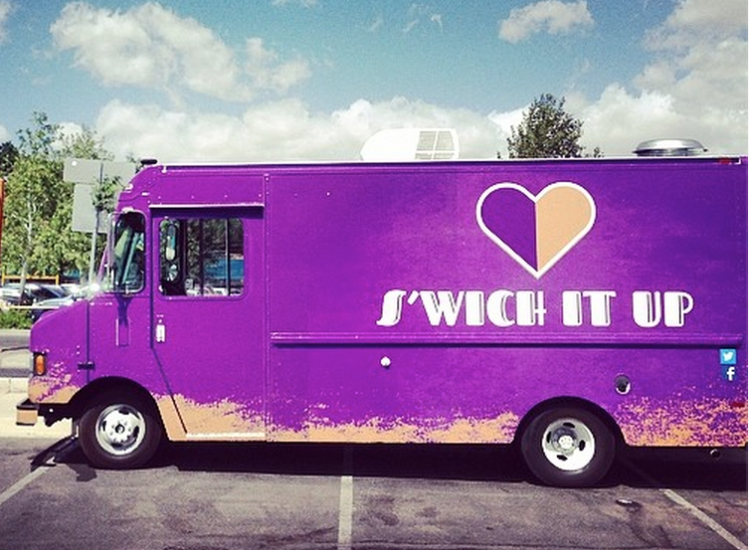
The S’wich It Up Food Truck in all her glory.
Step 1: Make your menu
Every great food truck business starts with the menu. And there are plenty of time-tested options that work well in a mobile setting including tacos, burgers, sandwiches, or ice cream. But no matter what menu you come up with, getting clear on what you plan to serve is a critical. The menu determines how much space you need for prep, the health code requirements, your brand, and even the cooking equipment you’ll need to install on the truck.
This advice seems basic, but first-time vendors make this mistake all the time. As Malcolm Bedell, veteran food truck owner and founder of The Original Honey’s Chicken Palace, wisely said, “The excitement of getting a good deal can sometimes cloud your judgment. Make sure you know exactly what you need before making a purchase.”
A Reddit user learned this mistake the hard way by investing in a low-cost trailer from Alibaba. But on arrival, the unit turned out to be cheaply made, barely functional, and unable to pass a health inspection. The trailer was also smaller than expected and unable to install the refrigerator, espresso machine, and 3-compartment sink required to execute the menu. In the end, this “cheap” trailer ended up costing the founder thousands.

Malcom outside his first food trailer.
Here’s another practical reason to start with the menu. Food trucks only have so much capacity to store ingredients. Creating streamlined menu allows you to carefully plan your ingredient purchases and run an efficient operation when you do hit the road. Be sure to select a cuisine that allows you the flexibility to remain creative for years, but also is specific enough so you don’t overstock your truck and create unnecessary food waste.
Here’s what I suggest. Grab a piece of paper and brainstorm a list of 5 – 6 menu ideas. Think about the kind of food you love and what would make your food truck stand out. Next, break down the ingredients you’ll need for each menu item and the equipment list you’ll need to execute it. This will help you see what’s feasible and what might be a bit too complicated.
For example, if your signature item is loaded tater tots, a commercial deep fryer will be a requirement. A prep table refrigerator would also be to keep toppings cool and easily accessible. Make a list of the cooking equipment required for each dish. This step is crucial because it directly impacts the setup of your food truck.
Go through this process methodically, and you’ll end up with a clear picture of what you need in your food truck. This way, you avoid the common mistake of buying a truck that doesn’t fit your menu needs. By planning your menu first, you ensure the truck is well equipped.
Step 2: Write a food truck business plan
That’s right… the dreaded business plan. Just the thought of writing one might take you back to high school, cramming for a term paper. But guess what? This step doesn’t need to be as bad as you’ve been taught.
Food truck business plans don’t need to be an exhaustive 100 page reports. After all, most food trucks are self funded ventures. They don’t require the approval of a board of directors or even a business loan. And they won’t be graded by the teacher.
I’ve seen plans of all sizes, starting at one page in length turn into successful businesses. The key is to invest time and effort into documenting the most important parts of a food truck business like the menu, ingredients, startup costs, potential vending locations, and profitability estimates for your business. You can check out the exact business plan I wrote here.
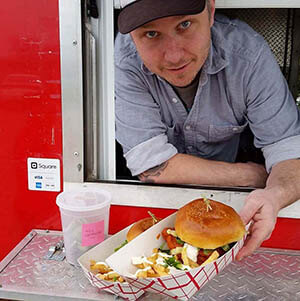
Order up.
Here is the basic structure of a food truck business plan:
- Executive summary: Introduce the name of your food truck and what you plan to serve.
- Mission statement: This should be a short description of the mission of your business. A mission statement works best if you print a copy of it to keep inside your food truck. This statement should guide the decisions of your business.
- Company concept / description: Write what you hope the food truck will become, the food you plan to serve, and why you believe it will be a successful business.
- Market analysis: Get an understanding of your local competition. What other food trucks are successful in your town? How do you intend to create a unique offering in your market?
- Management structure: This is a brief section in for most food trucks. Write down who will be participating in the business and the specific responsibilities of each team member.
- Product line: In the case of a food truck, publish your menu here.
- Sales and marketing: Write down how you plan to market your business and generate sales. Figuring out specific places you plan to vend is really important for food trucks in this section.
- Funding request: Share how much money you’ll need to start the business and list out exactly how you plan to spend each dollar. Buying the food truck or trailer will be the biggest startup expense.
- Financial projections: Share how much you plan to make. Great a goal of how many sales you plan per day and week on the unit. Estimate the profit margin based on your anticipated costs.
- Appendix: Include any supplemental information here. Ideas include a copy of your business and health department permits, photos of the truck, or anything else you think would be beneficial.
Step 3: Estimate total startup costs
It’s in your best interest to be as detailed as possible when figuring out your total costs by line item so you’re not surprised. In general, you can expect to pay between $28,100 – $114,100 to start a food truck. The startup cost could be even higher depending on the size of food truck and equipment.
Below are some of the most common startup costs expenses for a food truck business:
Food Truck Start-up Costs
| Equipment | Estimated Cost | Notes |
|---|---|---|
| Food Truck + Wrap & Equipment | $25,000 – $100,000 | Customize to fit your needs. |
| Initial Product Inventory | $1,000 – $2,000 | Stock up on essential ingredients. |
| Permits and Licenses | $100 – $500 | Varies depending on location. |
| Website | Free – $5,000 | Depends on complexity and features. |
| Social Media (Facebook/Twitter) | Free | Essential for marketing. |
| Register/POS | $200 – $1,000 | Consider using an iPad and app for transactions. |
| Uniforms/T-Shirts | $0 – $1,000 | Branded attire for staff. |
| Paper Products (Plates/Napkins, etc.) | $200 – $300 | Essential for serving food. |
| Misc. Expenses (e.g., Chalk Menu) | $500 – $2,000 | Budget for unexpected costs. |
| Smallwares (Pots, Pans, etc.) | $1,000 – $2,000 | Kitchen essentials. |
| Fire Extinguisher | $100 – $300 | Safety first! |
| Marketing Materials (Flyers, Business Cards) | $200 – $500 | For local promotions and events. |
| Cooking Oil Disposal | $100 – $300 | Ensure proper disposal of waste. |
| Cleaning Supplies | $200 – $500 | Maintain hygiene standards. |
| Generator | $2,000 – $5,000 | Ensure power supply. |
| Health Department Inspection Fees | $100 – $500 | Initial inspection costs. |
| Legal Fees | $500 – $2,000 | For setting up business structure and contracts. |
| Insurance (Truck and Liability) | $1,000 – $3,000 | Comprehensive coverage. |
Total Low End: $31,300
Total High End: $126,400
Food Truck On-Going Costs
| Item | Monthly Estimated Cost | Notes |
|---|---|---|
| Commissary | $0 – $1,200 | Depends on location and services. |
| Phone/Internet | $100 – $200 | Essential for operations and marketing. |
| Fuel | $500 | Variable cost. |
| Labor | $8 – $15 per hour | Budget for hourly wages. |
| Repairs | $1,000 | Plan for regular maintenance. |
| Food/Beverage Restock | Varies | Depends on menu and frequency. |
| Paper Product Restock | Varies | Depends on usage. |
| Insurance | $50 – $150 | Protect your investment. |
| Marketing/Advertising | $100 – $500 | Ongoing promotion costs. |
| Equipment Maintenance | $200 – $500 | Regular servicing of equipment. |
| Health Department Fees | $50 – $150 | Ongoing compliance costs. |
| Cleaning Supplies | $50 – $100 | Maintain hygiene standards. |
| Propane/Gas (if applicable) | $50 – $200 | For cooking equipment. |
| Parking Fees | $0 – $300 | For parking the food truck overnight. |
| Event Fees | Varies | Fees for participating in events and festivals. |
| Employee Training | $50 – $200 | Ongoing training and development. |
Total: Varies depending on specific costs.
As you can see, buying a food truck or trailer will be the biggest initial expense for your business. Here is a list of considerations when planning your truck build that impact the total startup cost.
What’s your budget? This will determine if you are buying a brand new truck built custom built to meet your specifications or a used unit.
How much food truck do you need? The size of your food truck can range from as small as a minivan to as large as a bus. The type of cuisine you serve plays a crucial role in determining the right size for your food truck. For example, a van might suffice for a coffee service or selling novelty ice cream, whereas a full-sized bus may be necessary for more extensive menus requiring more equipment and storage space. Choose a size that fits your menu and operational needs.
What type of equipment will you use? Equipment comes in all shapes and sizes and types and it can be easy to get overwhelmed, but try to keep it simple for now. Think about basics (refrigerator, flat top grill, prep table, shelves, generator, propane tanks, sinks, water heater, fire extinguishers, fume hoods, etc) and go from there. Remember you don’t need to buy anything right away, but having a general estimation of the cost will be very valuable when budgeting for this purchase. After you get an equipment list, find out how much each item costs and where you can purchase it.
When thinking of the truck and equipment you need remember to look at your local food truck regulations like fire safety and health requirements. These will also help guide you on any necessary equipment and safety considerations that you’ll need. For instance, some cities require trucks to have a fully working fume hood and kitchen fire extinguishers. Not every government has the same requirements so always take the time to research this step.
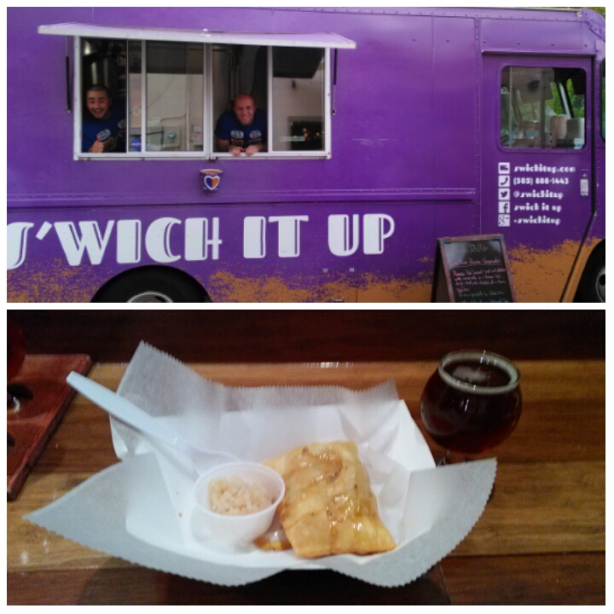
My brother and I serving up serving up some delicious empanadas at an event.
Now that you have a general idea of what you want or need you can start to go shopping:
Check out the huge list of builders on Food Truck Empire to find a builder near you that you can talk with and get a quote that meets your exact needs.
Check out used food truck marketplaces to see prices for trucks that are currently on the market. Even if you don’t want to buy a used food truck knowing what is available and how much it costs will help you understand your budget needs. You can find a more detailed list of places to buy a food truck in this post.
Finding a food truck that fits your needs and your budget is incredibly time consuming but it will prepare you for the next step…
Step 4: Food Truck Funding Options
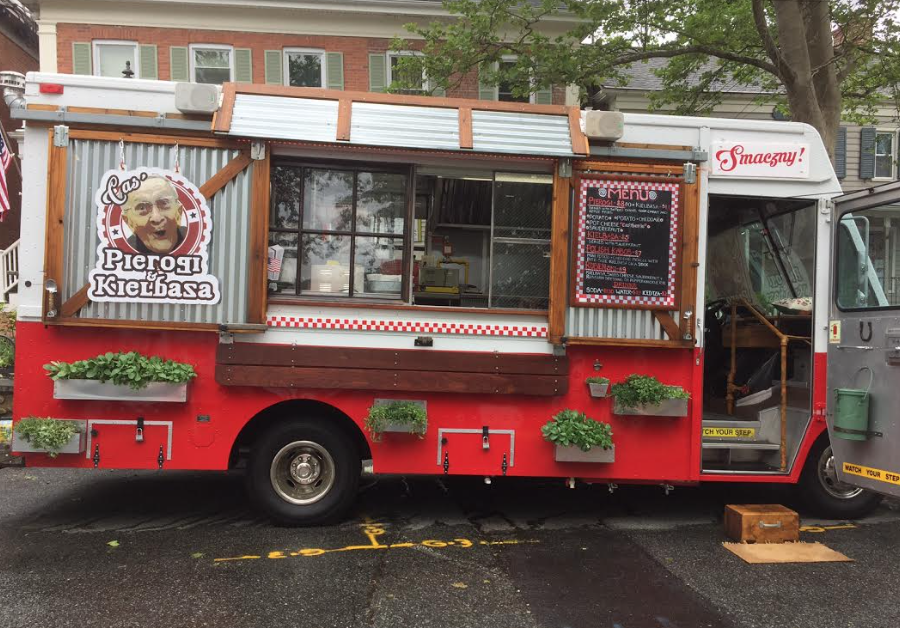
The official headquarters of Cas’ Pierogi & Kielbasa Food Truck.
Are you fortunate enough to be completely self-funding your business operations? Well then go right ahead and skip this step. For the rest of us, you’ll need to have a plan to raise capital.
Once you have a business plan and know how much funding you’ll need, you can start looking at your fundraising options. Here are some of the most common ways food trucks owners raise startup capital:
Founders with cash on hand or a savings account, can directly purchase the truck and start outfitting it with the necessary equipment. So if you happen to have five to six figures of cash, you can go ahead and buy a mobile unit outright. No further research needed!
Retirement accounts, including the 401K, are a common way to fund a food truck. While financial experts advise against this, the reality is many vendors have tapped these accounts to fund the business. One example is Marty Richie from Heavy Metal Grill based in Lakeville, Minnesota.
Marty leveraged his 401K early to pay for his food truck and ran the business on the weekend for the first 12 months of the business. This isn’t financial advice of course. But the reality is, most folks don’t have the cash on hand to cover all the startup costs, permits, and other overhead required to open this business.
Crowdfunding seems like a low hanging fruit, but it will require a massive effort to get startup capital this way. When Malcolm Bedell raised $29,457 for his first food trailer with KickStarter, he described the crowdfunding process as a full-time job for 3 months.
“I private messaged every connection I had on Facebook,” Bedell recalls. “I contacted all my family members and let them know about my plan a couple of months before the campaign to build excitement.”
Bedell advises against relying on crowdfunding to raise 100% of your funds because it takes so much time and effort to get the word out. On the flip side, if you only need to raise $1000 – $5000 to cover some final expenses for big ticket items like a generator this goal is much more attainable.
The biggest mistake Bedell sees with other crowdfunding campaigns that aren’t successful is the lack of planning and promotion before the campaign goes live.
Grants are extremely hard to get and very unlikely. There aren’t too many business grant opportunities, but you can partner with a nonprofit organization to create a really impactful program and do some social good. Think about partnering with shelters or family needs organizations to provide the food services. Usually in these instances, profitability is not the goal so keep that in mind before pursuing this option.
Family and Friends are always an available option. If you decide to ask family and friends to become potential investors and provide startup cash, keep the request extremely professional and make the terms of the agreement clear. You will need to clearly lay out the needs and detail all of the expectations for both parties.
Money can affect relationships both positively and negatively and you don’t not want this to play a role in your personal life, the business side is hard enough! If you borrow money, create a repayment plan. If there is no expectation of repayment get it in writing! Be clear, detailed, and precise.
Business loans are a lot of work to get. Let’s face it, when asking a bank for money you expect to be grilled and tested to determine how much risk the investment will be. They will most certainly require a business plan, a background check, a credit check, and maybe your first born (or unborn) child. Joking about the last one.
It will also be very difficult if you are a first time business owner, or your food truck is in its first year. But there are options out there so keep at it and persist. In fact your persistence will be a huge benefit, because that passion is what investors want to see.
Once you have secured some startup revenue you can begin to spend that money…
Step 5: Licenses, permits and insurance
There are a bunch of licenses and fees you’ll have to pay for right off the bat, but luckily these are inexpensive compared to the rest of the business operations. We’ve published an extensive checklist of food truck licenses and permits in this article.
First you will need to register your business with the IRS, then with your local state and city governments. Make it easy and use a service like ZenBusiness to handle all of this for around $200 or less depending on the state you live.
When you register a business, you will also be assigned an employee ID number or EIN. This EIN number is a requirement if you plan to bring on full-time or temporary employees for the business and allows the IRS to identify your business entity.
Next you’ll need to acquire some business licenses, most likely: a health permit and a fire safety permit. Not only are there nominal fees for these licenses, but you’ll also need to undergo inspection processes. Expect this to take some time to get prepared and approved. Make sure you communicate with your local offices early enough to figure out the required steps and timeline for these processes. Don’t forget to contact your local health department to find out the rules and regulations in your area.
In some area’s you may also need something called a seller’s permit for certain events. For example, if you want to vend at a local fair in a different area you might need acquire one of these permits for a few days. Fortunately, the event organizer will typically have the details of what you need already organized before participating in an event like a concert, street fair, or carnival.
Finally, you’ll need insurance. At the very least you will be required to have commercial auto insurance (this is a food TRUCK after all) and business general liability coverage. Each state has different insurance providers so make sure to ask around.
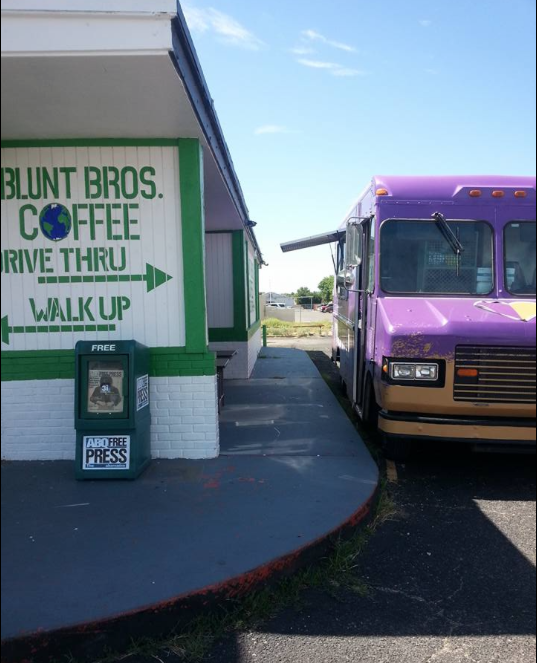
Just another day on the S’wich It Up food truck. :)
Step 6: Find a Point-of-Sale System (POS)
Finding a way to accept credits cards used to be a major pain for mobile food vendors. But fortunately there are all sorts of ways to accept mobile payments these days thanks to the dozens of different Point-of-Sale (POS) systems available in the market. POS systems allow customers to swipe their credit cards and collect online payments.
By far the most popular way to get started accepting payments on a food truck is with SquareUp. (By the way, this is not an affiliate link and we are not sponsored by this company.) The main reason this company has gained so much traction in the food truck community is because it’s free to setup an account and has no longterm contracts if you decide to move to another service.
Square makes money by charging 2.6% plus 10 cent processing fee with each in-person transaction. This small fee is well worth it for most vendors to be able to accept payments via debit or credit. You don’t need anything more than a dongle to swipe credit or debit cards either. You can start collecting payments from the food trucks window using your cell phone or an iPad if you want to keep costs low.
Step 7: Register Social Media Accounts
No food truck marketing campaign is complete without registering social media accounts on the biggest platforms. Many food trucks have gained popularity as a result of posting their food online. If you operate a food truck, you should never had a shortage of social media content as you make delicious meals, traveling to different events, and documenting your adventure.
In addition to reaching new customers, social media allows you to provide updates on your location and hours of operation. Both are essential to ensure your customers know where to find you. Here are the most common social media accounts for food trucks.
- Instagram – Instagram is an extremely valuable to food vendors since it is so image and visual driven.
- Facebook – This is viewed as the granddaddy of social media platforms, but there are still 2,797 million users on the platform including Millennials and Baby Boomers. Facebook makes it easy to list your hours of operation, contact information, menu, and post location updates.
- X – Twitter (now called X) has always been one of the best ways to announce the location of a truck.
Obviously there are dozens of social media opportunities that you can take advantage of and lots of opportunity to promote your business for free. But keep in mind you only have so many hours in a day to create content and interact with online followers. I suggest starting out with the most popular social media platforms to avoid overwhelm. After all, you’ve got food to serve and a business to run.
Step 8: Open for business
At this point the planning is finally complete. You are officially open for business. The next stage in the process is to get out there and put your business plan into action. This means finding vending locations, serving food, and getting the word out about your new business.
At this step it’s all about discovering if your business plan is correct. Are your first locations profitable? Do you need to find new vending spots? Are prospective customers resonating with your menu? Do you need to update the menu or adjust pricing? These first few months is all about getting out there, talking to people, and checking your numbers to find out if the business is working.
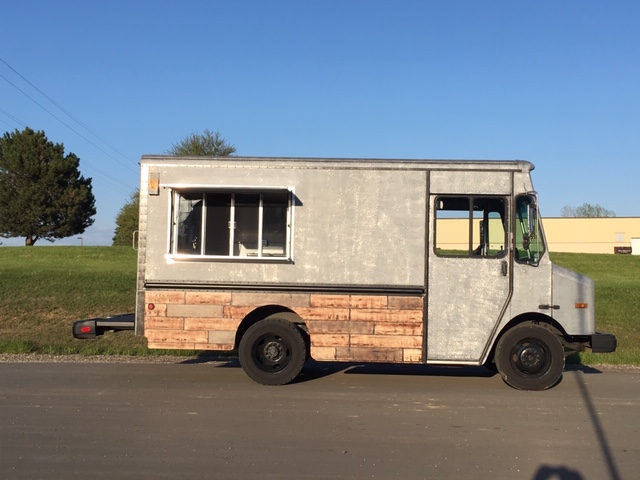
Box van converted into a food truck.
Frequently Asked Questions:
Advantages to Starting a Food Truck Business
As with any business model, there are advantages and disadvantages to starting a food truck business compared to a restaurant or kiosk. Here are a few of the advantages:
- You aren’t locked into a specific location. One of the biggest risks of starting a restaurant is that you’re pretty much stuck in one place. Overtime the demographics and appeal of a certain city can decline. A food truck can travel to where the most business is every day.
- Lower startup costs. It can cost well over $1 million dollars to start a restaurant. You can start a mobile food business for under $100,000 in most situations.
- You can get started part-time if you want. In the early days of any business, reaching profitability can be tough while you establish a brand name in your area. By starting a food truck on the weekends only, you can hold down a full-time employment in the early days and operate with less financial stress.
Disadvantages to Starting a Food Truck Business
Here are some of the challenges of operating this business:
- Hard work. Imagine setting up your truck each day at a new location. Then prepping food and serving customers for 3 hours only to close everything up and
- No frequent hours or location. If you’re always moving and vending at different events, it can be challenging for repeat customers to find you.
- Lack of storage space. With a restaurant, you can keep meats, diary, and other ingredients stored in a freezer or refrigerator. With a food truck, it’s tough store a lot of food, which can make operations more complex.
- Overnight parking and storage. Even though you operate a food truck, you’ll still need a safe place to store the vehicle overnight. Some counties require food trucks to park overnight at a commissary or commercial kitchen. This can add $500 – $2,000 per month to the expense column.
How Much Do Food Trucks Make Per Year? Per Day?
No two trucks will have the same revenue numbers, but to give you a sense of what to expect, I surveyed 223 food truck owners to get an estimate of the annual revenue for a food truck. Here are the results.
| Food Truck Income Survey | ||
| Annual Gross Income | Responses | % |
| Over $200,000 | 48 | 21.52% |
| $150,000 – $199,999 | 67 | 30.04% |
| $100,000 – $149,999 | 76 | 34.08% |
| $50,000 – $99,999 | 24 | 10.76% |
| Less Than $50,000 | 8 | 3.59% |
Keep in mind that the annual income you can make on a food truck will vary greatly on a variety of factors including your menu, how frequently you vend, where you live, and other factors.
Why Do Food Trucks Fail?
Food trucks that fail usually get the basics wrong and don’t take the time to research their business or write a business plan. Sometimes their food takes too long to make, which cuts down on profitability. Sometimes, it’s just a lack of marketing and planning where they’ll vend. Another issue is new vendors don’t understand how much work operating a food truck will actually be. You’ve got to be driven to start this business.
We interviewed 32 veteran food truck owners to gather insight into the reasons why their competitors went out of business. This is essential reading for anyone hoping to break into this industry.
The Bottom Line
You could write an entire book on the topic of starting a food truck and there are a lot of unique details to the process of getting started that will be unique to your city or region. As with any business, there are a lot of tiny little details to start a successful food business.
But take it from me and my experience, if you take it one step at a time and remember to enjoy the ride you will achieve your goal of owning and operating a food truck business of your very own. I wish you nothing but the best in your journey and encourage you to sign up for our free food truck business kit where you can download by complete business plan and other documents that will help you launch this business fast.




